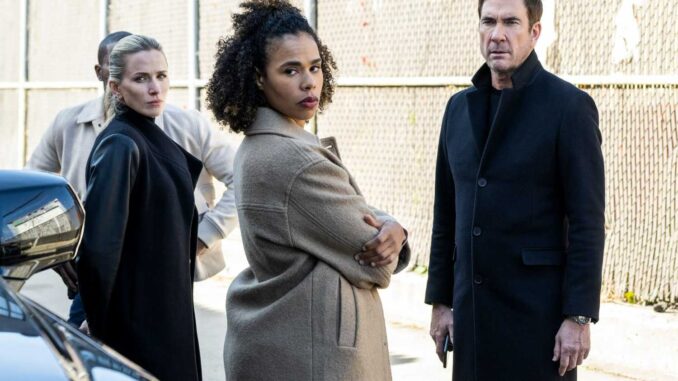
‘FBI: Most Wanted’ Revisits the 1985 MOVE Bombing in Midseason Premiere Images
As the midseason of the popular crime drama series “FBI: Most Wanted” approaches, fans and critics alike are buzzing with anticipation over the show’s latest storyline that delves into one of America’s most controversial and tragic events—the 1985 MOVE bombing. The premiere images released by the network have sparked intense discussions, highlighting the series’ bold move to tackle historical events with profound social and political implications.
A Bold Historical Turn for “FBI: Most Wanted”

Since its debut, “FBI: Most Wanted” has been lauded for its gripping narratives, intense character developments, and the intricate portrayal of high-stakes federal investigations. The series, which follows a dedicated team of FBI agents tasked with apprehending the nation’s most dangerous fugitives, has consistently pushed the envelope in terms of storytelling and thematic exploration.
This midseason, the show takes a significant departure from its usual focus on contemporary criminal cases by revisiting the 1985 MOVE bombing, a devastating incident that remains etched in the annals of American history. The MOVE organization, a Black liberation group based in Philadelphia, was subjected to a catastrophic police bombing that resulted in the deaths of 11 members and the destruction of 65 homes. The event has been a focal point of discussions around police brutality, systemic racism, and governmental accountability.
Premiere Images: A Glimpse into the Past
The recently released premiere images offer a poignant and visually striking portrayal of the MOVE bombing. The promotional materials feature a stark contrast between the serene suburban landscape and the impending chaos unleashed by the military intervention. Scenes depict FBI agents meticulously planning the operation, juxtaposed with the tense and volatile atmosphere within the MOVE compound.
One standout image showcases the lead characters, Special Agent Olivia Dalton (played by A.J. Buckley) and Special Agent Marcus Reed (portrayed by Harrison Thomas), standing resolute against a backdrop of flames and smoke. Dalton’s determined expression and Reed’s contemplative gaze hint at the moral and ethical dilemmas they will face as the investigation unfolds.
Another compelling image captures a tense standoff, with agents engaging in strategic maneuvers while civilians watch in horror. The meticulous attention to detail in the set design—replicating the MOVE compound and the surrounding neighborhood—adds a layer of authenticity that underscores the gravity of the event.
Reimagining a Tragic Chapter
The decision to revisit the MOVE bombing marks a pivotal moment for “FBI: Most Wanted”, as it intertwines historical reality with fictionalized investigative drama. This narrative choice allows the series to explore the complexities of law enforcement’s response to civil unrest and the fine line between maintaining order and respecting human rights.
Executive Producer Taylor Sheridan shared his vision for this storyline in a recent interview. “We wanted to honor the memory of those affected by the MOVE bombing by shedding light on the systemic issues that led to such a tragic outcome. It’s a story that demands reflection and understanding, and we believe it’s crucial to bring these conversations to the forefront through our platform.”
Character-Driven Storytelling Amidst Chaos
At the heart of this midseason premiere is the interplay between the FBI agents and the MOVE organization members. Olivia Dalton is depicted grappling with the moral implications of her duty, torn between her professional responsibilities and her personal convictions about justice and equity. Her internal conflict is a focal point of the narrative, providing a nuanced portrayal of an agent caught in the crossfire of historical events.
Marcus Reed, on the other hand, represents the pragmatic side of law enforcement, emphasizing strategy and protocol. His interactions with Dalton highlight the diverse perspectives within the FBI, adding depth to the characters and their development. The dynamic between Dalton and Reed is expected to drive the emotional core of the storyline, as they navigate the challenges posed by the MOVE case.
Historical Accuracy and Sensitivity
Addressing such a sensitive and impactful event requires a delicate balance between factual accuracy and dramatic storytelling. The production team has collaborated closely with historians and experts to ensure that the depiction of the MOVE bombing is both respectful and informative. Efforts have been made to authentically recreate the setting, uniforms, and protocols of the time, providing viewers with an immersive and truthful representation of the events.
Historical Consultant Dr. Angela Brooks, who specializes in 20th-century American history, commented on the project. “It’s imperative that media portrayals of events like the MOVE bombing handle the subject matter with the utmost care and accuracy. I’m pleased to see that ‘FBI: Most Wanted’ is taking this approach, ensuring that the narrative honors the victims and educates the audience about the broader societal implications.”
Audience and Critical Reception

The announcement of this historical arc has been met with a mix of excitement and apprehension from the audience. Long-time fans appreciate the show’s willingness to tackle challenging subjects, viewing it as a testament to the series’ growth and ambition. Social media platforms are abuzz with discussions, with hashtags like #FBIMostWantedMOVE trending as fans speculate about the potential developments and outcomes.
Critics have lauded the show for its boldness in addressing a pivotal moment in history. Emily Carter of The Hollywood Reporter praised the series, stating, “By delving into the MOVE bombing, ‘FBI: Most Wanted’ is not only expanding its narrative horizons but also contributing to important conversations about law enforcement and civil rights. It’s a courageous move that elevates the series beyond conventional crime dramas.”
Potential Impact and Legacy
Revisiting the MOVE bombing through a fictional lens allows “FBI: Most Wanted” to explore enduring themes of justice, accountability, and the human cost of systemic failures. The storyline has the potential to resonate deeply with viewers, fostering a greater understanding of historical injustices and their lasting impact on communities.
Moreover, this narrative choice positions the series as a socially conscious platform that is unafraid to engage with complex and uncomfortable truths. By doing so, “FBI: Most Wanted” not only entertains but also educates, bridging the gap between historical awareness and contemporary discourse.
Behind the Scenes: Crafting the Story
The creation of this midseason premiere involved extensive research and collaboration among the writers, directors, and actors. Showrunner Jeff F. King emphasized the importance of authenticity in portraying the MOVE bombing. “We approached this storyline with a profound sense of responsibility. Our goal was to honor the memory of those affected while providing a compelling and thought-provoking narrative that challenges our characters and our audience.”
The production design team meticulously recreated the 1985 Philadelphia landscape, ensuring that every detail—from the architecture of the MOVE compound to the surrounding neighborhood—reflected the period accurately. Special attention was given to the depiction of military tactics and police protocols, aiming to present a realistic portrayal of the events leading up to the bombing.
Character Arcs and Development
The MOVE bombing storyline serves as a catalyst for significant character development, particularly for Olivia Dalton and Marcus Reed. Dalton’s journey will involve confronting her own biases and the institutional pressures that shape her decisions, ultimately leading to a transformative arc that challenges her perceptions of justice and morality.
Reed’s character will explore the complexities of adhering to protocol in the face of moral dilemmas, highlighting the internal conflicts that arise when duty clashes with personal ethics. Their evolving relationship will underscore the broader themes of collaboration, understanding, and the pursuit of truth amidst chaos.
Viewer Engagement and Educational Opportunities
In addition to its narrative ambitions, “FBI: Most Wanted” is leveraging this storyline to engage viewers in meaningful discussions about historical events and their relevance today. The network has partnered with educational institutions and advocacy groups to provide supplementary materials and resources, enabling audiences to delve deeper into the MOVE bombing and its implications.
Interactive elements, such as behind-the-scenes documentaries and panel discussions with historians and civil rights activists, are being integrated into the promotional campaign. These initiatives aim to foster a more informed and empathetic viewer base, encouraging critical thinking and awareness.
Conclusion
The midseason premiere of “FBI: Most Wanted” promises to be a landmark moment for the series, as it courageously revisits the tragic 1985 MOVE bombing. Through meticulous research, sensitive storytelling, and powerful performances, the show is poised to deliver a narrative that is both emotionally resonant and socially significant.
As viewers prepare to witness this compelling portrayal of historical events, the anticipation continues to build. “FBI: Most Wanted” is not only expanding its storytelling repertoire but also contributing to a broader dialogue about justice, accountability, and the enduring impact of historical injustices.
Stay tuned for the premiere, set to air on June 10, 2025, and prepare to engage with a storyline that promises to leave a lasting impression on both the characters and the audience. “FBI: Most Wanted” continues to solidify its place as a thought-provoking and influential series in the landscape of modern television drama.
